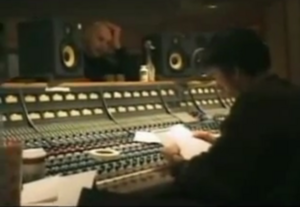November 1997-March 1998 – Sunset Sound
| November 1997-March 1998 – Sunset Sound | |
|---|---|
 | |
| Studio session of The Smashing Pumpkins | |
| Artist | The Smashing Pumpkins |
| Album | Adore |
| From | November 1997 |
| To | March 1998 |
| Location | Sunset Sound (Los Angeles) |
| Producer(s) | Billy Corgan |
| Engineer(s) | Neil Perry |
| Mixer(s) | Flood |
The November 1997-March 1998 Sunset Sound sessions was the second session for Adore, after relocating to Studio 2 at Sunset Sound. After months of aimless recording, Flood was brought in to sift through the 40-odd songs and assess what needed to be done to make an album out of the mountain of recordings. The final Adore album was a patchwork that drew from these sessions as well as the failed Chicago Brad Wood Sessions, the live CRC sessions and even some home recordings at Sadlands.
Billy reached out to Nitzer Ebb's Bon Harris, who contributed additional programming and sound design with the aid of his Nord Modular, Oberheim Xpander, and massive Roland System 100M. But the songs didn't come into full focus until Corgan reconnected with Flood, whose experience with bands like Depeche Mode and Nine Inch Nails made him the perfect candidate to help actualize Adore's hybrid vision.
Tracks recorded
- "Appels + Oranjes"
- "Blissed and Gone"
- "Blissed and Gone" (drone version)
- "Because You Are"
- "Cash Car Star"
- "Crestfallen"
- "Cross"
- "Czarina"
- "Do You Close Your Eyes?"
- "For Martha"
- "It's Alright"
- "Once Upon a Time"
- "Perfect"
- "Perfect" (no strings)
- "Perfect" (acoustic demo)
- "Pug"
- "Saturnine"
- "Saturnine" (piano/voice)
- "Shame"
- "Shame" (take 1)
- "Soot and Stars"
- "Summer" (instrumental)
- "The Tale of Dusty and Pistol Pete"
- "Waiting"
- "Winterlong"
- "17"
Unreleased
- "Tear" (remakes)
Background
The dissonance was evident to Flood upon arrival. The mix of disparate Pro Tools sessions and oneinch tape created a textured canvas that proved difficult to homogenize, and the tension between band members was palpable. The band worked at Sunset Sound until reoccurring technical difficulties with the Neve console forced them to complete the project at the Village Recorder in Santa Monica. To further Adore’s maudlin, Goth-tech spirit, Corgan assumed a Max Schreck-like persona, emphasizing his shaved head with lighting and make-up and donning long, flowing garb that accented his 6-foot 4-inch frame.
| “ | I did go around and proclaim rock to be dead, which was probably the stupidest thing I ever did. I was in my Adore personality saying Adore personality things like ‘F**k the electric guitar!’ And of course 12 months later I’m playing "The Everlasting Gaze." | ” |
| — Billy Corgan, Electronic Musician, 2012 | ||
Many fans attributed Adore’s stylistic shift directly to Chamberlin’s lack of participation, and contrary to favorable reviews and another Grammy nomination for Best Alternative Music Album, Corgan insists “nobody got the record.” “To Sheila” pumped blood through its mechanized heart, “Ava Adore” flashed her crooked teeth, but the bite wasn’t as strong. Chamberlin’s raw power was replaced by reverberating, distorted 808 kicks. Shuffle and swing turned into quantized grooves and fills. Predictable ticks marched along in place of glittering cymbal embellishments.
